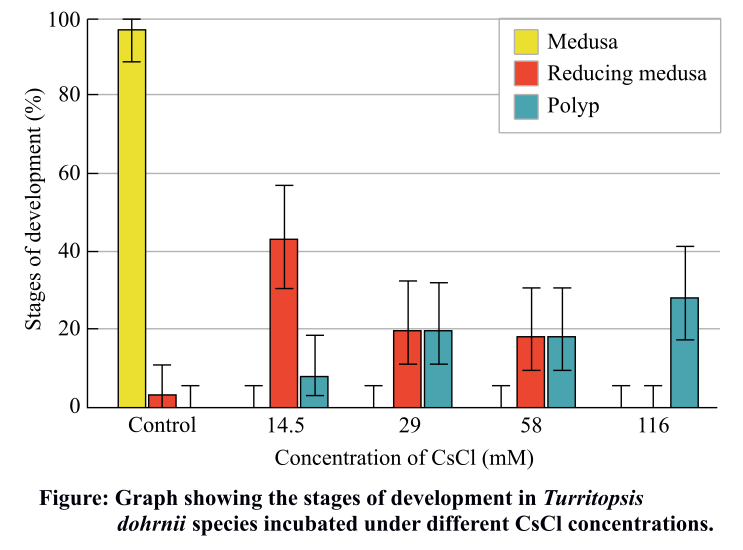
Concept explainers
To review:
The represented data are given in the graph and the purpose of reverse development in some cnidarians.
Introduction:
Cnidarians are marine, invertebrate, and radially symmetrical animals that belong to phylum Cnidaria. These animals do not have a complete gut instead have a blind sac called the gastrovascular cavity, which is connected to the single opening called the mouth. The cnidarians exhibit two distinct stages during its life cycle.
Explanation of Solution
The life cycle of all cnidarians involves the formation of two distinct body forms: one sessile (immobile) and other motile. The sessile stage is known as the polyp, which is cylindrical in structure and is attached to a substratum, while the motile stage is known as the medusa, which is umbrella or bell shaped and is free swimming in the sea. The polyp stage exhibits the asexual young stage that converts into the medusa stage representing the sexual mature phase of the organism.
Some cnidarians such as Turritopsis dohrnii shows the reversal of sexual mature phase into young asexual phase. This reversal process is referred to as the reduction. The medusa stage under reduction into its younger version is called as the reducing medusa. Such cnidarians are regarded as “immortal jellies.” Research has shown that this revert back process occurs when the organism faces stress conditions in its surrounding such as unavailability of food, injury, and unfavorable conditions to sexually reproduce.
The following graph represents the data generated when the Turritopsis dohrnii species were incubated under different concentrations of cesium chloride (CsCl) for 3 hours, as a part of a study of reversion phenomenon shown by this species.

From the graph, it is clear that at CsCl concentration of 14.5 mM (low), maximum number of reducing medusa stages were recovered as compared to the control where no stress is given and maximum number of normal medusa stages were seen. At intermediate CsCl concentrations (29 Mm and 58 mM), equal number of reducing medusa stages and polyp stages were seen. However, at very high CsCl concentration (116 mM), absence of reducing medusa was seen while maximum number of polyp stages were recovered. This represents the reversion of all the medusa stages into the polyp stage.
Therefore, it can be concluded that as the stress conditions increase in the environment of cnidaria, the revert back phenomenon is more as more number of medusa stages starts reverting back to the young polyp stages. This reversion process contributes to the immortality of these animals.
Want to see more full solutions like this?
Chapter 30 Solutions
Life: The Science of Biology
- Which of the following is not a member of the phylum Chordata? a. Cephalochordata b. Echinodermata c. Urochordata d. Vertebrataarrow_forwardCompare the body plan of Dugesia and cnidarians. Aside from differences in symmetry, what other innovative anatomical features did you observe in Dugesia that were not observed in cnidarians?arrow_forwardAll cnidarians have cnidoblasts, but not all cnidoblasts sting. What else could an ejecting thread do to capture a prey organism?arrow_forward
- Why was the medusa stage lost in some cnidarians? Do you think it is more advantageous to have both forms (medusa and polyp)? Why or why not?arrow_forwardDefine what are Cnidarians ? Explain the role of Cnidarians ?arrow_forwardArthropods usually have a distinct head. How would you define a “head”? What are the advantages and disadvantages of having such a body region?arrow_forward
- In addition to a spinal column, what key feature distinguishes members of Vertebrata from Chordata? Question 21 options: Quadripedal Locomotion Hardened Endoskeleton The Notochord Body Hairarrow_forwardIdentify the two features of body plan that evolved with the cnidarians and ctenophores. Explain the significance of these features to their biological processes including locomotion, body support, reproduction, and development. ? _____________________________ ? ______________________________ Locomotion and body support Reproduction and developmentarrow_forwardINSTRUCTIONS: Do not copy in Google Please answer all, they are connected to the question QUESTION: Identify the basic characteristics and specialized features exclusive to each phylum of invertebrates. Echinodermata Hemichordata Chordataarrow_forward
- Compare and contrast the hydraulic skeleton of molluscs with the hydrostatic skeletons of cnidarians and pseudocoelomates.arrow_forwardMembers of Chondrichfhyes are thought to be descended from fishes that had. a cartilaginous skeleton a bony skeleton mucus glands slime glandsarrow_forwardConsidering the presence of segmentation (metameres) in their body to which other already studied phylum are arthropods proximal?arrow_forward
 Concepts of BiologyBiologyISBN:9781938168116Author:Samantha Fowler, Rebecca Roush, James WisePublisher:OpenStax College
Concepts of BiologyBiologyISBN:9781938168116Author:Samantha Fowler, Rebecca Roush, James WisePublisher:OpenStax College
 Biology 2eBiologyISBN:9781947172517Author:Matthew Douglas, Jung Choi, Mary Ann ClarkPublisher:OpenStax
Biology 2eBiologyISBN:9781947172517Author:Matthew Douglas, Jung Choi, Mary Ann ClarkPublisher:OpenStax


